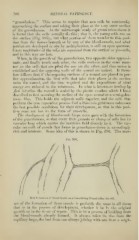Page 696 - My FlipBook
P. 696
706 GENERAL PATHOLOGY.
" granulations." This seems to require that new cells be continually
approaching the surface and taking their place at the very outer surface
of the granulations. In the microscopic study of granulation-tissue it
is found that the cells actually do this ; that is, the y
tion from the tissues beneath or by way of the blood-vessels, and what
portion are developed in mtu by multiplication, is still an open question.
Great multitudes of the cells are separated from the surface as pus-cells,
and in this May are lost.
When, in the growth of the granulations, two opposite sides approxi-
mate, and finally touch each other, the cells coalesce in the same man-
ner as the cells that are piled the one on the other, and thus union is
established and the opposing walls of the wound are united. It there-
fore follows that if the o])posing surfaces of a wound are placed in per-
fect approximation, the first cells that take their places at the surface
unite the wound, and the time required and the expenditure of vital
energy are reduced to the minimum. In what is known. as healing by
first intention the wound is sealed by the plastic exudate which I have
described as first covering the surface of the open wound as a semi-gelat-
inous film. This holds the adjacent walls together, and the cells that
perform the true reparative process find within this gelatinous substance
the best possible conditions for their development, so that in this posi-
tion none are lost in the form of pus-cells.
The development of blood-vessels keeps even pace with the formation
of the granulations, so that every little granule or clump of cells has its
vascular loop which carries the nutritive fluid directly to it. The vas-
cular network of vessels that forms in granulation-tissue is exceedingly
rich and intricate. Some idea of this is shown in Fig. 396. The man-
FiG. 39G.
New Formation of Rlood-vcssels in a Oranulatinfj AVound (after Arnold).
ner of the formation of these vessels is jirobably the same in all tissue
that is in the process of development, whether it be in the original
growth or in the tissue of repair. This is by a process of budding from
the blood-vessels already formed. It always takes its rise from the
capillary loops, the bud from one always joining with one from a neigh-


